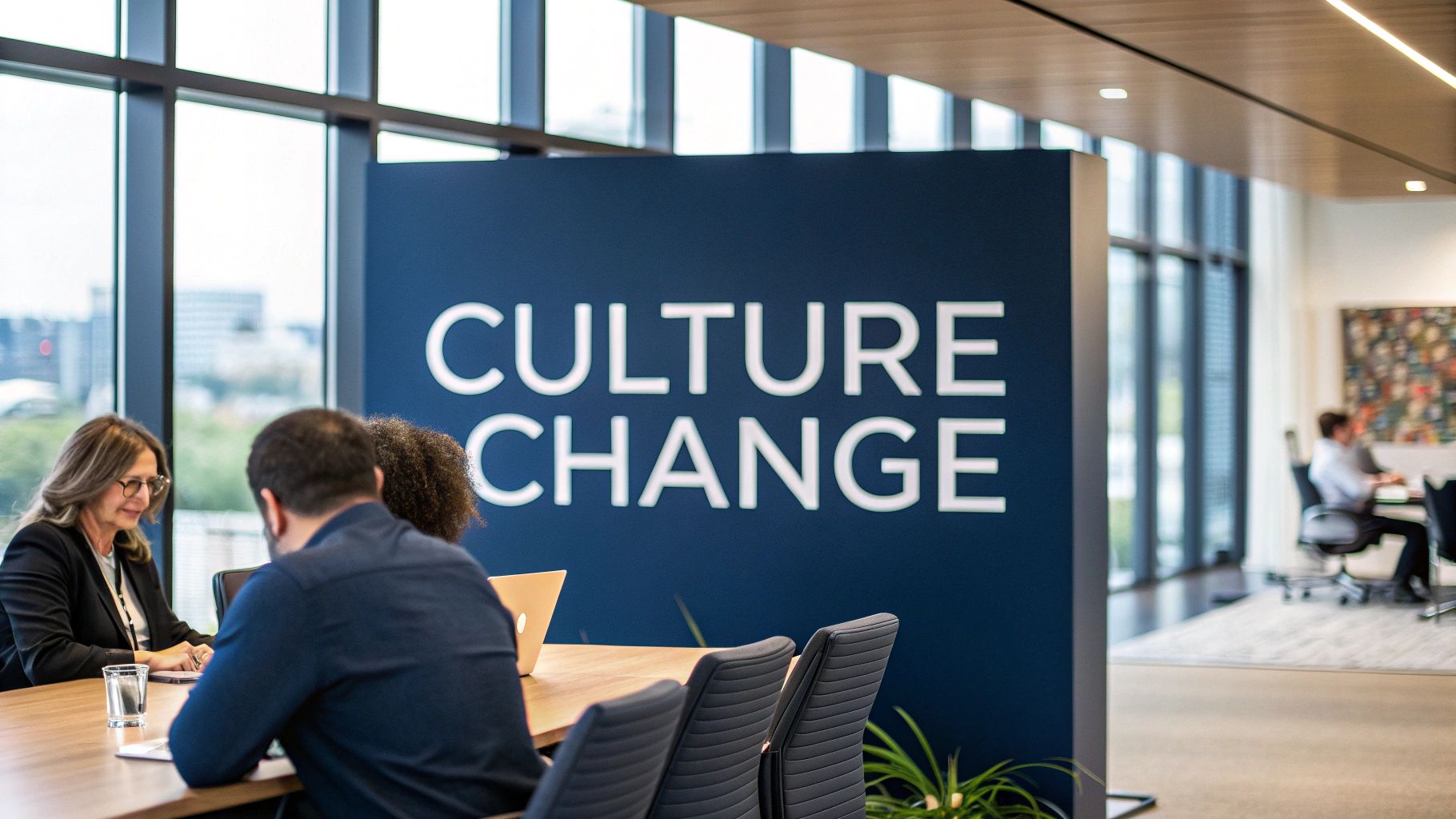Understanding the True Impact of Corporate Culture
A strong company culture acts as a key driver of business success by creating an environment where employees can collaborate effectively and solve challenges together. Companies that actively build a positive and inclusive workplace see better performance compared to their competitors - not just in good times, but especially during difficult periods.
The Role of Culture in Navigating Challenges
The COVID-19 pandemic highlighted just how much company culture matters. Organizations with strong cultural foundations proved more resilient and adaptable during this unprecedented time. Research shows that 70% of companies credited their positive workplace culture for helping them overcome pandemic-related obstacles. For instance, 69% of executives reported that their company's success during this period stemmed directly from having a strong cultural foundation. See more detailed findings here.
Shifting From Metrics to Cultural Indicators
More companies now look beyond traditional performance metrics to measure cultural health. This reflects growing evidence that workplace culture directly impacts everything from how engaged employees feel to how customers view the business. While financial results matter, they often follow naturally from the positive outcomes of a healthy work environment. As a result, businesses are developing better ways to assess and improve their cultural practices.
Practical Frameworks for Cultural Assessment
Getting an accurate picture of company culture requires looking at multiple factors beyond basic surveys. Companies need to examine:
- Daily Interactions: How employees communicate and work together
- Leadership Behaviors: The example managers set and their impact on team morale
- Employee Feedback: Anonymous input about workplace satisfaction and values
| What to Measure | Assessment Method | Expected Benefits |
|---|---|---|
| Communication | Regular feedback channels | Better transparency and trust |
| Leadership Impact | 360-degree reviews | Stronger management practices |
| Team Engagement | Periodic culture checks | Higher satisfaction and retention |
Companies that make culture a core part of how they operate are better prepared to handle change and encourage new ideas. By focusing on building and maintaining a positive workplace environment, organizations create lasting value that helps them succeed over the long term.
Mastering Leadership's Role in Cultural Transformation

Great leaders shape how teams work together. When leaders create an environment of trust and open feedback, remarkable things happen. I've seen firsthand how leaders who stay true to their word and communicate openly build confidence across their organizations. Teams work better together, conflicts decrease, and people feel heard. Research shows that when leaders actively seek and act on feedback, employees are twice as likely to feel like they belong at work.
Building Trust and Encouraging Feedback
Trust grows when leaders show up consistently. Each meeting, decision, and conversation is a chance to demonstrate company values in action. When leaders model openness and honesty, it gives everyone permission to communicate more directly. The proof is in the numbers - studies find that leaders who welcome feedback see 66% less employee burnout. Setting up clear ways for people to share ideas and concerns helps build trust at every level. Learn more about how leadership shapes company culture here.
Developing Leadership Capabilities
Building strong leaders takes focused effort and practice. The best organizations invest in developing leadership skills throughout their ranks. Here's what works:
- Hands-on Workshops: Regular training sessions that teach practical leadership skills
- Mentorship: Pairing experienced leaders with up-and-coming talent
- Team Projects: Getting leaders working across departments to broaden their perspective
These development opportunities help leaders grow while keeping company values front and center.
Balancing Change with Stability
Change is tricky - you need to move forward without losing what works. Leaders play a key role in helping teams adapt while staying focused on core goals. Some proven approaches include:
- Regular Updates: Keeping everyone informed about what's changing and why
- Step-by-Step Changes: Making shifts gradually so teams can adjust
- Ongoing Support: Offering help through training and support services when needed
Measuring Leadership Effectiveness
To know if leadership efforts are working, you need both stories and data. Smart organizations track:
- Employee engagement levels
- How many people stay vs leave
- What the team climate surveys say
- Feedback from all directions (360 reviews)
These measures show how leadership impacts the overall health of the culture, letting you adjust course as needed.
In closing, strong leadership in cultural change comes down to building trust, developing people's abilities, managing change carefully, and measuring what matters. When organizations focus on these fundamentals, they create lasting positive change in how people work together.
Creating a Culture of Innovation and Adaptability

Building an environment where new ideas thrive and teams adapt quickly has become essential for business success. Companies that get this right create spaces where employees feel empowered to experiment, learn from mistakes, and respond effectively to market changes.
Encouraging Innovative Thoughts Across the Board
Fresh thinking shouldn't be limited to R&D or creative teams - it needs to flow throughout the entire organization. Regular brainstorming sessions help bring diverse perspectives together, while cross-team projects spark unexpected solutions. When companies make it clear that every employee's ideas matter, they create natural momentum for improvement and growth.
Making Room for Smart Experimentation
The most effective way to test new approaches is through small, controlled trials where teams can learn without major business disruption. By treating setbacks as valuable feedback rather than failures, organizations help their people take smart risks. This practical approach builds confidence and resilience while generating insights that drive the business forward.
Finding the Sweet Spot Between Innovation and Operations
Success comes from striking the right balance between exploring new possibilities and maintaining smooth day-to-day operations. One effective method is dedicating specific resources and time for pilot projects. This creates space for testing fresh ideas while keeping core business processes running smoothly.
Building Adaptable Teams
To stay competitive, companies need teams that can shift gears quickly when market conditions change. Here are proven ways to develop this capability:
- Scenario Planning: Regularly exploring potential future challenges and opportunities
- Continuous Learning: Supporting ongoing skill development through targeted training
- Cross-Training: Having team members learn different roles to build versatility
When innovation becomes part of everyday work rather than a special initiative, companies develop natural advantages that help them evolve and grow. The key is creating an environment where creative problem-solving and quick adaptation become standard practice rather than exception.
Measuring Cultural Transformation Success

When improving company culture, smart measurement makes all the difference. The most effective organizations use a mix of hard numbers and real employee experiences to track their progress. This balanced approach helps companies understand what's working and what needs attention.
Using Numbers and Stories Together
Good measurement combines concrete data with human insight. Here's what successful companies track:
- Employee Surveys: Regular check-ins to see how people feel about their work
- Staff Turnover: Changes in how many people stay or leave
- Open Communication: Both formal meetings and casual conversations to hear what employees think
Using both types of data gives managers a clear picture of how culture changes over time.
Practical Ways to Check Progress
Companies can use these straightforward tools to keep tabs on cultural health:
- Culture Reviews: Regular checks to see if daily work matches company goals
- Industry Comparisons: Looking at similar companies to spot areas for improvement
- Team Discussions: Small group talks to understand specific concerns and ideas
This systematic approach helps turn observations into real improvements that benefit both people and results.
Setting Clear Goals
When working to improve company culture, it helps to focus on specific targets:
| What to Measure | What It Shows | Why It Matters |
|---|---|---|
| Employee Engagement | How motivated and committed teams are | Affects work quality and loyalty |
| New Ideas | How often teams suggest improvements | Shows if people feel free to innovate |
| Leadership Impact | How well managers support their teams | Builds trust and teamwork |
These clear targets let companies track real progress and adjust their approach based on what employees actually experience.
Finally, measuring cultural change takes both careful tracking and flexibility. By paying attention to various signs of cultural health, companies can create better workplaces where both people and business thrive.
Building Sustainable Cultural Change

Creating lasting change in company culture requires more than surface-level fixes. It's about making cultural values so deeply ingrained that they become second nature in daily work life. Success often comes from studying what has and hasn't worked for other organizations, then adapting those lessons thoughtfully.
Embedding Cultural Elements Across the Organization
Getting culture changes to stick means weaving them into every part of how a company operates. Smart hiring makes a big difference - 70% of successful companies focus on finding candidates who genuinely connect with their values and mission. Here's what helps culture take root day-to-day:
- Training That Matters: Build cultural elements into onboarding and ongoing learning
- Open Communication: Set up clear ways for employees to share ideas and concerns
- Leaders Who Walk the Talk: Management needs to demonstrate cultural values consistently through actions, not just words
Maintaining Momentum in Transformation Initiatives
When culture shifts are underway, keeping energy high is key. Employees need to see that changes are meaningful and lasting, not just the latest management fad. Some practical ways to maintain momentum:
- Small Wins Matter: Set achievable short-term goals to show real progress
- Highlight Success Stories: Recognize teams and individuals who bring cultural values to life
- Keep the Conversation Going: Share regular updates about cultural initiatives to maintain focus
Creating Self-Reinforcing Cultural Systems
The best cultural changes gain strength over time without constant pushing from the top. This happens when you build systems that naturally encourage positive behaviors:
- Buddy Networks: Connect newer employees with experienced ones to share cultural knowledge
- Mix Teams Up: Have different departments work together to spread shared values
- Check and Adjust: Regularly assess how well cultural changes are sticking and tweak as needed
The bottom line is that lasting cultural change needs time, attention and commitment at all levels. By focusing on these concrete steps, organizations can build cultures that grow stronger naturally over time.
Future-Proofing Your Organizational Culture
Smart leaders know that building a strong company culture isn't a checkbox exercise - it's an ongoing journey of growth and evolution. Just as your body's immune system protects against illness, a well-developed culture helps your organization handle unexpected changes and challenges. The key is preparing for tomorrow's needs, not just today's demands.
Developing Cultural Resilience
A resilient culture starts with clear shared values and honest, open dialogue between all team members. When companies make learning and knowledge-sharing a priority, they're better equipped to adopt new tools and approaches. Psychological safety plays a vital role too - when people feel secure speaking up about concerns and suggesting solutions, it creates a stronger sense of shared ownership. This collective responsibility makes the whole organization more stable.
Maintaining Cultural Strength During Growth
Fast growth can test even the most established cultures. Like a thriving plant that needs repotting, your company's values need extra care during periods of expansion. The solution is purposefully weaving core values into every new hire and initiative. Clear communication and consistent behavior from leaders become especially important during rapid changes. This helps preserve your unique identity while ensuring values stay meaningful for an expanding team.
Fostering Adaptability Without Losing Identity
Being able to adapt is essential, but not at the cost of losing what makes your organization special. Think of it like a chameleon - it changes colors to match its environment while staying true to its nature. Companies need this same balance - evolving practices to meet new challenges while protecting fundamental values. By defining clear non-negotiable principles, organizations can try new approaches while keeping their cultural foundation intact. This creates room for healthy growth while preserving what matters most.
Ready to explore further how to build a future-proof culture and achieve true freedom in your business and life? Tune in to The Covered Call Podcast for inspiring stories and actionable strategies from successful entrepreneurs and investors.

